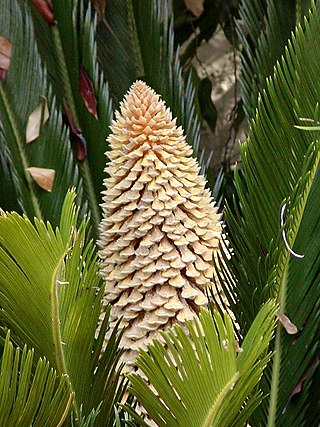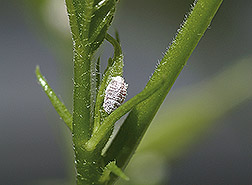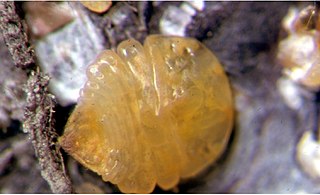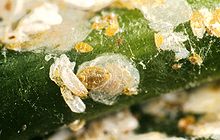
Scale insects are small insects of the order Hemiptera, suborder Sternorrhyncha. Of dramatically variable appearance and extreme sexual dimorphism, they comprise the infraorder Coccomorpha which is considered a more convenient grouping than the superfamily Coccoidea due to taxonomic uncertainties. Adult females typically have soft bodies and no limbs, and are concealed underneath domed scales, extruding quantities of wax for protection. Some species are hermaphroditic, with a combined ovotestis instead of separate ovaries and testes. Males, in the species where they occur, have legs and sometimes wings, and resemble small flies. Scale insects are herbivores, piercing plant tissues with their mouthparts and remaining in one place, feeding on sap. The excess fluid they imbibe is secreted as honeydew on which sooty mold tends to grow. The insects often have a mutualistic relationship with ants, which feed on the honeydew and protect them from predators. There are about 8,000 described species.

Cycas revoluta is a species of gymnosperm in the family Cycadaceae, native to southern Japan including the Ryukyu Islands. It is one of several species used for the production of sago, as well as an ornamental plant. The sago cycad can be distinguished by a thick coat of fibers on its trunk. The sago cycad is sometimes mistakenly thought to be a palm, although the only similarity between the two is that they look similar and both produce seeds.

The silverleaf whitefly is one of several species of whitefly that are currently important agricultural pests. A review in 2011 concluded that the silverleaf whitefly is actually a species complex containing at least 40 morphologically indistinguishable species.

Encephalartos is a genus of cycad native to Africa. Several species of Encephalartos are commonly referred to as bread trees, bread palms or kaffir bread, since a bread-like starchy food can be prepared from the centre of the stem. The genus name is derived from the Greek words en (within), kephalē (head), and artos (bread), referring to the use of the pith to make food. They are, in evolutionary terms, some of the most primitive living gymnosperms.

Maconellicoccus hirsutus, is a pest of many plants, trees, and shrubs. It infests hibiscus, citrus, coffee, sugar cane, annonas, plums, guava, mango, okra, sorrel, teak, mora, pigeon pea, peanut, grapevine, maize, asparagus, chrysanthemum, beans, cotton, soybean, cocoa, and many other plants. The pest forms colonies on the host plant, and if left undisturbed, the colonies will grow into large masses of white waxy coverings on branches, fruiting structures, leaves, and even whole plants, including large trees.

Cycas micronesica is a species of cycad found on the island of Yap in Micronesia, the Marianas islands of Guam and Rota, and The Republic of Palau. It is commonly known as federico nut or fadang in Chamorro. The species, previously lumped with Cycas rumphii and Cycas circinalis, was described in 1994 by Ken Hill. Paleoecological studies have determined that C. micronesica has been present on the island of Guam for about 9,000 years. It is linked with Lytico-Bodig disease, a condition similar to amyotrophic lateral sclerosis (ALS), due to the neurotoxin BMAA found in its seeds, which were a traditional food source on Guam until the 1960s. The neurotoxin is present due to its symbiosis with cyanobacteria.

Diaspididae is the largest family of scale insects with over 2650 described species in around 400 genera. As with all scale insects, the female produces a waxy protective scale beneath which it feeds on its host plant. Diaspidid scales are far more substantial than those of most other families, incorporating the exuviae from the first two nymphal instars and sometimes faecal matter and fragments of the host plant. These can be complex and extremely waterproof structures rather resembling a suit of armor. For this reason these insects are commonly referred to as armored scale insects. As it is so robust and firmly attached to the host plant, the scale often persists long after the insect has died.

Aleurocanthus woglumi is a species of whitefly in the family Aleyrodidae. It is a pest of citrus crops, and is commonly known as the citrus blackfly because of its slate-blue colour. It originated in Asia, but has spread to other parts of the world. The parasitic wasps, Encarsia perplexa and Amitus hesperidum can help control the pest.

Planococcus citri, commonly known as the citrus mealybug, is a species of mealybugs native to Asia. It has been introduced to the rest of the world, including Europe, the Americas, and Oceania, as an agricultural pest. It is associated with citrus, but it attacks a wide range of crop plants, ornamental plants, and wild flora.

Aonidiella orientalis is a species of insect in the family Diaspididae, the armored scale insects. It is known commonly as the Oriental yellow scale. It is an agricultural pest on a wide variety of crop plants.
Aonidiella citrina or yellow scale is an armored scale insect from the family Diaspididae. It feeds by sucking sap from plants in a number of plant families, but is mostly known for being a pest of citrus.

Pseudaulacaspis pentagona, the white peach scale or mulberry scale, is a species of armoured scale insect in the family Diaspididae. This scale infests over 100 different genera of plants including many fruit trees and ornamentals.
Hemiberlesia lataniae, the latania or palm scale, is a species of armored scale insect in the family Diaspididae. It was first described by the French entomologist Victor Antoine Signoret in 1869 using Latania lontaroides, a species of palm tree endemic to Réunion as its host; since then, it has been found on avocado trees growing in South Africa, Australia, Israel, the United States, and on a range of other plants in many parts of the world.

Aspidiotus destructor, the coconut scale, is a species of armoured scale insect in the family Diaspididae, found in many tropical and subtropical parts of the world. It is a serious pest of coconut and banana, and attacks a range of other fruiting trees and ornamental plants.
Aleurotrachelus atratus better known as the palm-infesting whitefly is an invasive species that affects coconut palms. Originally, this species was only prevalent in Brazil and was known to feed on coconuts native to this country. Now, the species has migrated to the tropics and subtropics and is invasive in many other countries. Aleurotrachelus is one of the largest genus, containing 74 species.

Protopulvinaria pyriformis, commonly known as the pyriform scale, is a species of soft scale insect in the family Coccidae. It is a pest of avocado and is found in many countries around the world where avocados grow.

Quadraspidiotus juglansregiae, commonly known as the walnut scale, is a species of armoured scale insect in the family Diaspididae. It is native to North America where it feeds on a wide range of ornamental and forest trees and bushes.
Carulaspis minima is an armoured scale insect, in the subtribe Diaspidina of the family Diaspididae, and is commonly known as the minute cypress scale. It was first described in 1869 by the French entomologist Victor Antoine Signoret. It feeds on evergreen conifers in the families Cephalotaxaceae, Cupressaceae and Taxodiaceae.
Selenaspidus articulatus is an armoured scale insect in the family Diaspididae, commonly known as the West Indian red scale. It is a polyphagous species found in tropical and subtropical regions around the world as a pest species of Citrus and other fruit and ornamental trees.

Planococcus ficus, commonly known as the vine mealybug, is a species of mealybug, belonging to the family Pseudococcidae, native to tropical and subtropical regions. The vine mealybug is found in Europe, Northern Africa, Southern Africa, the Americas, and the Middle East. The vine mealybug is invasive to weedy plants in many different regions of the world.















